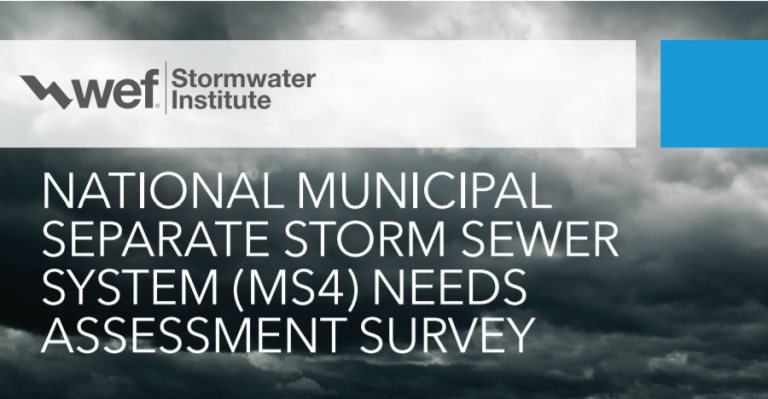As heavy storm events become more frequent and impervious coverage spreads, the gap between current U.S. investment in stormwater management and the level necessary to satisfy Clean Water Act requirements continues to widen.
According to the latest estimates from the U.S. Environmental Protection Agency (EPA), bolstering stormwater infrastructure to effective levels will require nearly $70 billion during the next 20 years. However, EPA reports that only about 1,600 out of more than 7,500 U.S. Municipal Separate Storm Sewer System (MS4) permittees have a dedicated stormwater funding source in place, such as a stormwater tax or stormwater utility fee.
A new report, “Evaluating Stormwater Infrastructure Funding and Financing,” explores the U.S. stormwater funding gap and recommends ways to address it. The report, authored by a team of experts in stormwater management and finance as well as representatives of local, state, and federal governments, calls for establishing new stormwater funding programs, expanding existing programs, and enhancing outreach about the importance of stormwater management.
Fernando Pasquel, Chair of the Water Environment Federation (WEF; Alexandria, Virginia) Stormwater Institute Advisory Committee and a Senior Vice President at Arcadis (Arlington, Virginia), served as an expert consultant during the report’s composition.
“Stormwater infrastructure is as important to quality of life as wastewater and water infrastructure, roads or electricity,” Pasquel said. “Therefore, we, as a sector, must find better ways to fund stormwater programs and communicate the broader benefits of stormwater.”
Strengthening and Streamlining Stormwater Finance
Many of the report’s recommendations call for increased federal investment in existing water infrastructure funding programs as well as establishing new programs specifically intended to support stormwater infrastructure.
For example, authors recommend strengthening Clean Water State Revolving Loan Funds (CWSRFs) and the Water Infrastructure Finance and Innovation Act (WIFIA) program by creating new stormwater-focused provisions. For CWSRFs, this could include creating a new sub-program or expanding eligibility for the existing CWSRFs to include stormwater and flood management projects, the report describes. The WIFIA program could benefit from explicit information about stormwater project eligibility.
Other report recommendations focus on streamlining access to existing sources of stormwater funding. Because federal grant programs applicable to stormwater management projects are often managed by separate agencies, each with their own set of application requirements, many small, rural, and disadvantaged communities often lack the technical or financial resources necessary to take full advantage of federal funding, the authors write.
The report points to the Common App, currently accepted by nearly 900 U.S. colleges and universities, as a model for the federal grant application process. Distilling common requirements among all federal infrastructure grants into a single application would save both the applicant and the reviewer time and resources, according to the report.
Authors acknowledge that allocating new sources of funding for any program does not happen in a vacuum; it requires familiarity with the issues being addressed and buy-in from both elected officials and the constituents they represent. New, dedicated sources of local stormwater funding may involve additional taxes or ratepayer fees, the report describes, which are likely to face resistance unless utilities and municipalities have the tools to educate locals about growing threats and opportunities from stormwater. The report recommends funding educational programs targeted at illustrating the linkage between stormwater investments and economic development for local residents.
Public education approaches could involve providing funds to establish dedicated stormwater utilities or expand the scope of existing utilities into the stormwater sector. Much like drinking water and wastewater utilities, these organizations would undertake community outreach activities to demonstrate how investment in stormwater management directly benefits public health and safety, economic opportunity, and water quality. The report also recommends establishing an online compendium of case studies that detail innovative approaches to stormwater financing and their resulting co-benefits: The report features 20 such case studies applicable to a variety of climates and community sizes.
Anticipated By U.S. Congress
The report directly responds to America’s Water Infrastructure Act (AWIA), passed by U.S. Congress in 2018. AWIA language (Section 4101) required EPA to create a Stormwater Finance Task Force, comprised of 13 members of EPA’s Environmental Financial Advisory Board as well as 20 invited consultants specializing in financing stormwater infrastructure and programs. AWIA charged the task force with conducting a study on current funding availability for stormwater infrastructure and recommending ways to improve it.

Establishing a Stormwater Finance Task Force was also a recommendation of the 2018 Water Environment Federation (WEF; Alexandria, Virginia) Stormwater Institute Water Week Factsheets and the MS4 Needs Assessment Survey, the first national effort of its kind to identify common challenges among U.S. stormwater permittees. While formulating the report, the Stormwater Finance Task Force incorporated data from the survey as well as from eight other regional assessments of the stormwater funding gap.
After review from EPA, the report was submitted to U.S. Congress in April 2020.





